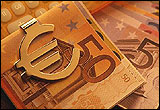
The agony of the Euroimperial dream
While the euro has five candles on its cake, those nostalgic for the franc and other detractors of the single currency have the wind firmly in their sails. And, even if Slovenia becomes the thirteenth member state of the euro zone on January 1, the blues have won over most of the participants in the adventure. Thus, between September 2002 and November 2006, the perception of the advantages of the single currency fell from 59 to 48 pc in the European Union, according to a Eurobarometer. Take France: a recent TNS-Sofres poll showed that 52 percent of French people believe that the euro is “a bad thing” for France, compared to 45 percent in December 2003… And, in Germany, 58 percent of those questioned say that they would return to the mark if they could choose. Several factors help to understand this decline in European enthusiasm for the single currency. “Fears have been expressed in particular regarding the increase in prices,” observes Françoise Bernard, head of “Financial Markets” at Fortis. Many will have had the impression that with the euro, a hole had been punched in their wallet. (Source: La Libre, 12/29/2006).
 We announced a long time ago that the euro was a bad project. Events confirm the analysis: stagnation and mass unemployment, worsening inflation, public disaffection… Faced with this state of affairs, supporters of the single European currency resort to two arguments.
We announced a long time ago that the euro was a bad project. Events confirm the analysis: stagnation and mass unemployment, worsening inflation, public disaffection… Faced with this state of affairs, supporters of the single European currency resort to two arguments.
 On the one hand, the euro would only bear apparent responsibility for the rise in prices; it would all be a matter of psychology… But the Europeans are not fooled. In reality, official inflation is underestimated. The prices that have increased the most (because consumer control has been made more difficult) are those of everyday consumer items – those that weigh the most in the household basket. Items were taken out of the price range, and companies stopped producing some of the cheapest items to produce new ones at new prices.
On the one hand, the euro would only bear apparent responsibility for the rise in prices; it would all be a matter of psychology… But the Europeans are not fooled. In reality, official inflation is underestimated. The prices that have increased the most (because consumer control has been made more difficult) are those of everyday consumer items – those that weigh the most in the household basket. Items were taken out of the price range, and companies stopped producing some of the cheapest items to produce new ones at new prices.
 On the other hand, according to supporters of the euro, it would be impossible to go back without incurring “extremely significant” costs and damage. This pseudo-argument, which aims to scare, had already been used at the time of the changeover to the euro. In reality, national central banks have the ability to easily print national currencies again. The transition to a system of coordinated European currencies, like the old “monetary snake”, is feasible, would allow competitiveness differentials to be managed flexibly, and would present advantages even greater than the possible disadvantages. The European Central Bank would guarantee this, and it would be reformed to include the promotion of growth and employment in its statutory objectives.
On the other hand, according to supporters of the euro, it would be impossible to go back without incurring “extremely significant” costs and damage. This pseudo-argument, which aims to scare, had already been used at the time of the changeover to the euro. In reality, national central banks have the ability to easily print national currencies again. The transition to a system of coordinated European currencies, like the old “monetary snake”, is feasible, would allow competitiveness differentials to be managed flexibly, and would present advantages even greater than the possible disadvantages. The European Central Bank would guarantee this, and it would be reformed to include the promotion of growth and employment in its statutory objectives.










